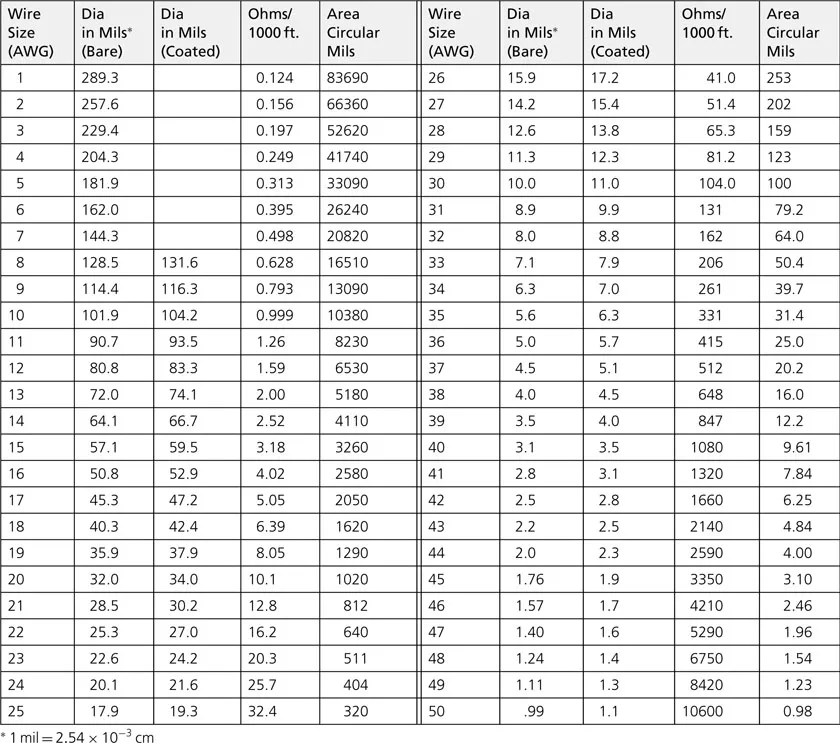In this chapter, we will discuss the properties of resistors, capacitors, and inductors at radio frequencies as they relate to circuit design. But, first, let’s take a look at the most simple component of any system and examine its problems at radio frequencies.
WIRE
Wire in an RF circuit can take many forms. Wirewound resistors, inductors, and axial- and radial-leaded capacitors all use a wire of some size and length either in their leads, or in the actual body of the component, or both. Wire is also used in many interconnect applications in the lower RF spectrum. The behavior of a wire in the RF spectrum depends to a large extent on the wire’s diameter and length. Table 1-1 lists, in the American Wire Gauge (AWG) system, each gauge of wire, its corresponding diameter, and other characteristics of interest to the RF circuit designer. In the AWG system, the diameter of a wire will roughly double every six wire gauges. Thus, if the last six gauges and their corresponding diameters are memorized from the chart, all other wire diameters can be determined without the aid of a chart (Example 1-1).
EXAMPLE 1-1
Given that the diameter of AWG 50 wire is 1.0 mil (0.001 inch), what is the diameter of AWG 14 wire?
Solution
AWG 50 = 1 mil
AWG 44 = 2 × 1 mil = 2 mils
AWG 38 = 2 × 2 mils = 4 mils
AWG 32 = 2 × 4 mils = 8 mils
AWG 26 = 2 × 8 mils = 16 mils
AWG 20 = 2 × 16 mils = 32 mils
AWG 14 = 2 × 32 mils = 64 mils (0.064 inch)
Skin Effect
A conductor, at low frequencies, utilizes its entire cross-sectional area as a transport medium for charge carriers. As the frequency is increased, an increased magnetic field at the center of the conductor presents an impedance to the charge carriers, thus decreasing the current density at the center of the conductor and increasing the current density around its perimeter. This increased current density near the edge of the conductor is known as skin effect. It occurs in all conductors including resistor leads, capacitor leads, and inductor leads.
The depth into the conductor at which the charge-carrier current density falls to 1/e, or 37% of its value along the surface, is known as the skin depth and is a function of the frequency and the permeability and conductivity of the medium. Thus, different conductors, such as silver, aluminum, and copper, all have different skin depths.
The net result of skin effect is an effective decrease in the cross-sectional area of the conductor and, therefore, a net increase in the ac resistance of the wire as shown in Fig. 1-1. For copper, the skin depth is approximately 0.85 cm at 60 Hz and 0.007 cm at 1 MHz. Or, to state it another way: 63% of the RF current flowing in a copper wire will flow within a distance of 0.007 cm of the outer edge of the wire.
Straight-Wire Inductors
In the medium surrounding any current-carrying conductor, there exists a magnetic field. If the current in the conductor is an alternating current, this magnetic field is alternately expanding and contracting and, thus, producing a voltage on the wire which opposes any change in current flow. This opposition to change is called self-inductance and we call anything that possesses this quality an inductor. Straight-wire inductance might seem trivial, but as will be seen later in the chapter, the higher we go in frequency, the more important it becomes.
The inductance of a straight wire depends on both its length and its diameter, and is found by:
where,
L = the inductance in µH,
l = the length of the wire in cm,
d = the diameter of the wire in cm.
This is shown in calculations of Example 1-2.
EXAMPLE 1-2
Find the inductance of 5 centimeters of No. 22 copper wire.
Solution
From Table 1-1, the diameter of No. 22 copper wire is 25.3 mils. Since 1 mil equals 2.54 × 10–3 cm, this equals 0.0643 cm. Substituting into Equation 1-1 gives
The concept of inductance is important because any and all conductors at radio frequencies (including hookup wire, capacitor leads, etc.) tend to exhibit the property of inductance. Inductors will be discussed in greater detail later in this chapter.
RESISTORS
Resistance is the property of a material that determines the rate at which electrical energy is converted into heat energy for a given electric current. By definition:
The thermal dissipation in this circumstance is 1 watt.
Resistors are used everywhere in circuits, as transistor bias networks, pads, and signal combiners. However, very rarely is there any thought given to how a resistor actually behaves once we depart from the world of direct current (DC). In some instances, such as in transistor biasing networks, the resistor will still perform its DC circuit function, but it may also disrupt the circu...






